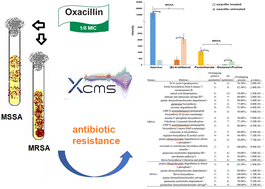Nontargeted metabolomics reveals differences in the metabolite profiling among methicillin-resistant and methicillin-susceptible Staphylococcus aureus in response to antibiotics†
Abstract
Staphylococcus aureus (S. aureus) causes infections and can be fatal. In the long-term struggle against antibiotics, S. aureus has acquired resistance toward antibiotics and become more difficult to kill. Metabolomics could directly reflect the responses of S. aureus toward antibiotics, which is effective for studying the resistance mechanism of S. aureus. In this study, based on a nontargeted metabolic figure printing technique, the metabolome of a pair of isogenic methicillin-susceptible and resistant S. aureus strains ATCC25923 (MSSA) and ATCC43300 (MRSA) treated with or without oxacillin was characterized. 7 and 29 significantly changed metabolites in MRSA and MSSA were identified by combined accurate mass and mass fragmentation analysis. Pathway enrichment analysis suggested that DNA repair and flavin biosynthesis are the universal pathways of both MSSA and MRSA under antibiotic stress. MRSA systematically and effectively fights against oxacillin through precise control of energy production, PBP2a substrate biosynthesis and antioxidant function. In contrast, MSSA lacks effective defense pathways against oxacillin. The different metabolome responses of MSSA and MRSA toward antibiotics provide us with new insights into how S. aureus develops antibiotic resistance.



 Please wait while we load your content...
Please wait while we load your content...